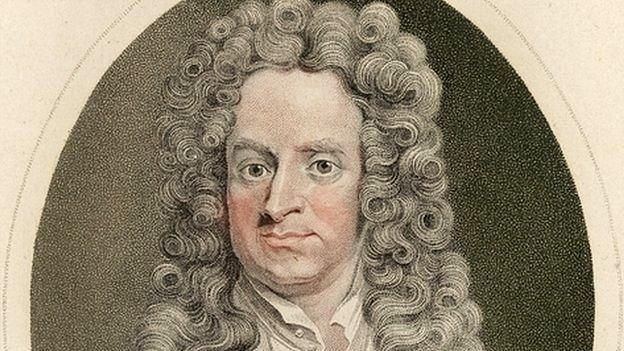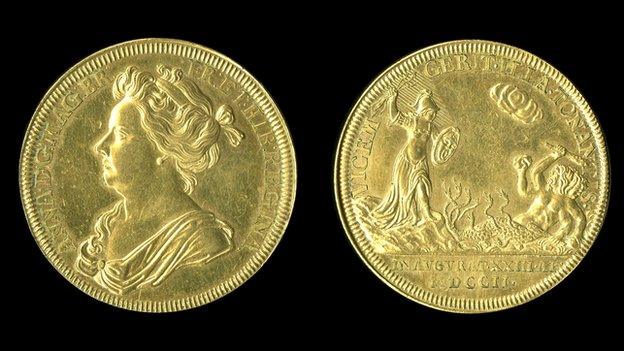Isaac Newton royal medal design discovery
- Published

The discovery shows that Sir Isaac Newton could turn his hand to design as well as science and maths
A student at Oxford University has discovered that a coronation medal was personally designed by Isaac Newton and includes a hidden political message.
Postgraduate student Joseph Hone found a manuscript which revealed the scientist had designed the medal for Queen Anne's coronation in 1702.
It explained the design as symbolising the dual threats of France and rival Stuart claimants to the throne.
It was described as a "really exciting discovery" by the project leader.
Researching in the National Archives in Kew, Mr Hone found Newton's handwritten account of designing the commemorative medal.
The 50-page document had been overlooked for years, he said, as the clasp holding the pages had rusted over.
Propaganda message
The design had previously been thought to have been the work of a court painter, but the manuscript shows that Newton, who was Master of the Royal Mint at the time, was responsible.

The medals were produced to commemorate the coronation of Queen Anne
Newton's notes reveal that the depiction of the queen as a Greek goddess striking down a monster was not a random picture of a national defender, but a specific reference to contemporary political threats to her rule.
In the iconography of this 18th Century propaganda, the creature with two heads represents the joint threat of the French king, Louis XIV, and the so-called "Old Pretender", James Stuart.
Queen Anne was the daughter of the deposed Catholic monarch, James II, and the old king's son, James Stuart, was living in exile and claiming that he had a more legitimate right to the throne.
The medal shows Queen Anne facing this threat of a Catholic alliance between France and the exiled Stuarts, headed by her half-brother James.
Gold versions of the medal were to be given out to "persons of quality", according to the notes, with cheaper silver versions to be thrown to the crowds.
The medal also divided opinion along contemporary political lines, says Mr Hone, with the Tories "really disliking" it as an attempt to present the new queen in a way that would be more sympathetic to the rival Whigs.
Arts and sciences
Mr Hone, an English PhD student on a Oxford and Exeter university project, says the discovery casts more light on Newton's professional career and how his work moved between science, maths and humanities.
"The modern obsession with separating science and the humanities falls down when you go back a few centuries," he said.
"It's not that he didn't see them as separate, but more that he saw them as inseparable."

The statue of Queen Anne outside St Paul's Cathedral, monarch at the cathedral's completion in 1710
He says the notes show Newton switching ideas from science to maths, classical history, politics and literature.
"It tells us that Newton didn't conceive of himself as a scientist, but a master of lots of trades. The understanding of him as a great scientist is a later imposition, he would have seen himself more as a public servant."
The project is examining the transitions between different Stuart reigns and looking at public responses during these times of "regime change".
It was a moment when people wanted to advance their own cause by putting themselves on the right side of the incoming ruler.
The co-director of the project, Paulina Kewes, from Oxford's English department, described the findings as a "really exciting discovery".
"The notes and sketches for this medal give us an insight into the politics surrounding Anne's succession and Isaac Newton's surprising role in them."